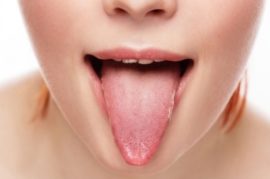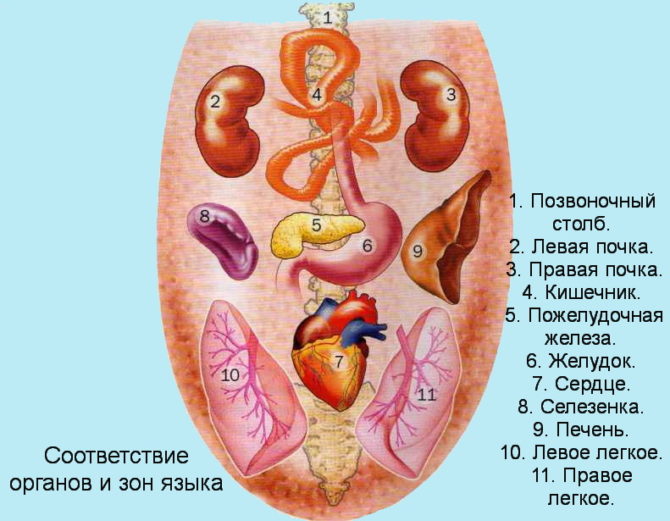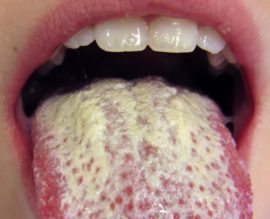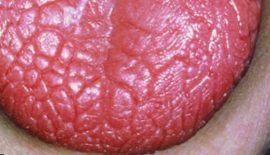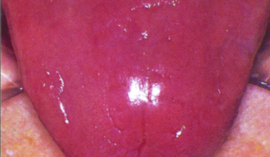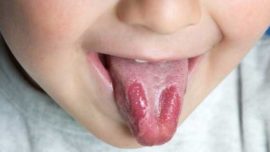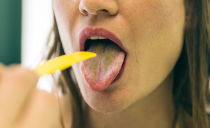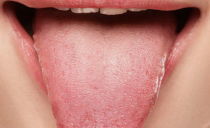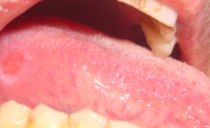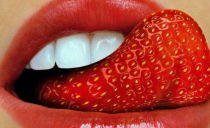Diagnosis of human diseases by language
In many ancient states where medicine was developed, people believed in hidden connections between different organs. Some doctors tried to find answers about human health by examining their language. Science has evolved, and many views on the diagnosis of disease by language have changed, but even modern doctors find evidence of this connection.
Modern doctors believe that certain language properties do not indicate an accurate diagnosis, but they help to know the direction of diagnosis. So from time to time it is advisable to look at this organ and consult a doctor if its color or shape changes.
Content
Diagnostic signs
If the vital processes are balanced, the body functions without failures, the human language has a healthy appearance. This is manifested in its smooth, velvety surface, uniform pink color and a transparent coating of saliva. There should be no discomfort, burning, tingling or lack of sensitivity in any areas.
In the human body, pathologies are determined by the following characteristics:
- Color and its uniformity on the surface of the tongue.
- Smell, color and plaque consistency.
- Relief.
- The shape of the organ and the line in the middle.
- Movement.
- A sense of taste.
Diagnosis of health by language should be carried out as follows: stick it out as much as possible, look in the mirror and analyze all of these characteristics. The sensations of taste and touch, the accumulation of plaque should be observed throughout the day. All the features that could be identified should be compared with text descriptions.
If the patient tells the doctor about the change in health status and the results of the diagnosis by language, he will be given an examination to clarify the diagnosis.
Correspondence of the zones of the tongue to the internal organs
Ancient Chinese doctors determined that each section of this muscular organ is associated with a particular element. Modern medicine has established how the zones of the human tongue are associated with diseases of the internal organs. Compliance is given in the table:
| Zone | Element | Organs |
|---|---|---|
| Tip of the tongue | Fire | Small intestine, heart muscle |
| Transverse strip between tip and central region | Metal | Large intestine, immunity, respiratory system |
| Mid | Land | Stomach, spleen, pancreas |
| Sides | Wood | Gall bladder, liver |
| Rear part | Water | Organs of the lower abdomen, reproductive and urinary systems |
| A fold dividing the tongue into left and right parts | — | Spine |
For a more informative diagnosis, it is necessary to take into account both the general condition of the language and the condition of its individual sections. It is important to understand that the doctor draws conclusions not only on indirect external changes, but also on the results of laboratory, instrumental studies, and when making a diagnosis, more should be based on the conclusions confirmed by the analyzes.
Color diagnostics: what the color of the tongue says
The color of this organ partly depends on the shade of its own tissues, partly on the accumulation of plaque on it. By studying the color of the tongue, you can determine what this symptom is talking about and go to the therapist to check your assumptions.Below is the correspondence of the color of the plaque of the tongue and the diseases that may be associated with this:
- A coated yellowish tongue is a symptom of abnormal liver function, gastrointestinal tract and a sign of smokers.
- Bright red plaque - the presence of hematological and cardiovascular pathologies.
- Reddish plaque is a sign of inflammation of an infectious or non-infectious origin.
- Dark red plaque is a manifestation of intoxication.
- The red tip of the tongue is a symptom of diseases of the pelvic organs.
- Burgundy plaque - the presence of acute infections.
- Raspberry is a manifestation of a severe infection with severe fever.
- Blue, purple tongue is a symptom of lung or heart disease.
- Blue plaque is a sign of kidney disease.
- Gray - the presence of chronic diseases of the gastrointestinal tract.
- Black plaque is a sign of infection with a chromogenic fungus or a condition of acidosis.
- Pallor is a symptom of an infection of fungal origin, acute respiratory viral infections, anemia, dehydration of tissues, and exhaustion of the body.
- The pale underside of the tongue in humans is a sign of diseases of the liver and the gallbladder associated with it.
- A dirty gray coating is a consequence of the life of the parasites.
The presence of spots
The color of the tongue in some diseases is uneven, there may be distinct or unclear spots, stripes:
- The presence of red and white spots indicates the presence of scarlet fever.
- White spots on the edges or over the entire surface indicate the development of thrush.
-
White flaky spots on the tongue indicate the presence of lichen planus.
- White spots on the lower part of the tongue are observed with vascular diseases of the brain or with oxygen starvation.
- The presence of one round white spot indicates a shift in the acid-base balance of the gastric juice.
- A red spot on the tip of the tongue or along the edges - injuries resulting from rough food or due to biting with teeth.
- Red dots on the top indicate mononucleosis or hematopoiesis problems.
- Reddened areas with horny scales are a likely sign of a tumor.
- A red spot surrounded by yellowish vesicles is a symptom of erythema.
- Reddened areas in a dry tongue are a sign of brain disease.
- Red vesicles around the edges are a symptom of herpes.
- Yellow spots are a sign of inflammatory processes, diseases of the blood forming organs, oncology, necrosis, the consequence of smoking.
- Purple patches indicate blood stasis.
- Brown spots are a sign of a circulatory disease or bleeding in the mouth.
- Blue spots are a sign of hemangioma, intoxication, or blood disease.
- Blackening of certain areas is a sign of chemical burns, the consequence of smoking, prolonged use of antibiotics, stomatitis or gastrointestinal tract disorders.
Form Diagnostics
The definition of a human disease by language is also based on the analysis of its shape and shape of the midline:
| Tongue shape | Definition of the disease by language |
|---|---|
| Thin | Metabolic malfunctions |
| Thick | Impaired digestive tract and liver |
| A long | Heart problems |
| Convex | Pulmonary pathology |
| Hydropic | Impaired digestion |
| Midline curvature | Pathology of the spine |
| One side of the tongue adjoins the cheek | Pathologies of cerebral circulation, strokes |
| Tongue changed shape and relief | Hypo - or vitamin deficiency |
It is difficult for a person without a medical education from photographs or a description to determine what form of an organ is the norm for him. So, a thick tongue can be mistaken for puffiness. therefore do not draw conclusions on your own health status and treatment, it is better to consult a doctor and tell him about your assumptions.
Landform
Normal taste buds form a smooth, velvety surface. By the relief of the tongue, you can determine the disease in an adult or child, how to do it:
-
Excessive roughness indicates dehydration, problems with the salivary glands, an overdose of antibiotics, atropine drugs or fat-soluble vitamins.
- Increased roughness in a person’s dry tongue, sometimes with tooth imprints, can tell about gastrointestinal disease, it happens with appendicitis, intestinal infections, and ulcerative pathologies. If cracks are added to dryness, uneven edges are a possible sign of diabetes.
-
The symptom of a “varnished tongue”, in which the surface becomes too smooth due to atrophy of the taste buds, is observed with colitis, stomach cancer or problems with the absorption of vitamin B
- Diagnosis of the color of the tongue and its relief is evident with pellagra - hypovitaminosis of nicotinic acid and vitamin B. The tongue looks ribbed due to cracks and is covered with hard to remove brown coating. Then the scarlet “Cardinal language” is formed, shown in the image on the right. At a late stage, a “lacquered tongue” appears.
-
Alternating normal and inflamed papillae form a “geographical tongue” - a kind of pattern with grooves, which is more common in allergic children or with mental disorders. The projection of spots on the internal organs will help diagnose which organ is suffering from food allergies, vitamin deficiency, and atopic dermatitis.
Movement and sensitivity
Normally, a person carries out movements of the tongue without difficulty, without trembling and muscle pain. If there are diseases of the nervous system and neurasthenic syndromes, a characteristic trembling appears, and with strokes, patients have difficulty chewing and talking. When hemorrhages in the brain are partially or completely absent, the sensitivity of taste buds, and touch of the surface.
The causes of tremors can be not only neurological, but also endocrine. The progression of brain diseases in the later stages leads to a decrease in muscle size.
With the appearance of uncharacteristic sensations, burning, you should contact a neurologist. If only the surface of the organ hurts, it is covered with plaque, turns pale, you need to show it to the dentist, this can be a sign of inflammation of the mucous membrane - stomatitis.
The function of the taste buds is also used in the diagnosis of diseases by language, it can change with burns, smoking or hormonal failures and is often accompanied by an accumulation of plaque.
In pregnant women, a change in taste preferences and an aversion to normal food can appear in the first trimester or persist for all 9 months. In some women, this feature is the first sign of a successful conception.
Prevention of tongue diseases
To reduce the risk of diseases of the tongue and other organs, you need to monitor your diet, daily routine, less contact with infectious patients. Care for the tongue itself should be no less thorough than for the teeth.
Accumulating plaque, especially in sick people, is the place of mass reproduction of bacteria and fungi. If you do not remove it in time, it will become a source of infectious pathogens that can penetrate into any part of the body.
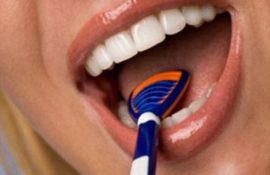 When cleaning the oral cavity, it is useful to use toothbrushes having a ribbed back surface to cleanse the tongue from plaque, or special spoons, scrapers. But they must be used carefully so as not to damage the taste buds and mucous membrane. After cleaning, it is advisable to use pharmacy rinses or prepare homemade decoctions of herbs.
When cleaning the oral cavity, it is useful to use toothbrushes having a ribbed back surface to cleanse the tongue from plaque, or special spoons, scrapers. But they must be used carefully so as not to damage the taste buds and mucous membrane. After cleaning, it is advisable to use pharmacy rinses or prepare homemade decoctions of herbs.
Is it worth it to diagnose by language
For several hundred years now, doctors have been studying the question of which diseases can be identified by language. The results of studies of ancient and modern scientists show that this relationship exists, but it must be correctly understood and evaluated.If a healthy person has irregularities or the color of the plaque has changed, this phenomenon may be the very first symptom of the disease, which will manifest itself in the future by other deviations.
There is an assumption that the imprints of the disease appear on this organ a few days before its clinical signs, but you should not use diagnostics in the human language for further self-medication. This is a whole science, and only a good specialist can understand it. Treatment can begin only after a full examination and the establishment of a correct diagnosis.


